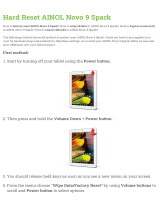
i
Chapter 1. Getting to know your computer ..........................................1
Top view.......................................................................................................................1
Left-side view ..............................................................................................................5
Right-side view............................................................................................................6
Front view ....................................................................................................................7
Bottom view.................................................................................................................8
Chapter 2. Learning the basics............................................................ 10
Configuring the operating system for the first time ............................................10
Operating system interfaces ....................................................................................10
The Charms................................................................................................................11
Putting the computer to sleep or shutting it down..............................................13
Using the touchpad...................................................................................................15
Function key combinations......................................................................................16
Connecting external devices....................................................................................18
Special keys and buttons..........................................................................................20
System status indicators...........................................................................................22
Securing your computer...........................................................................................23
Using Switchable Graphics (specific models only) ..............................................23
Chapter 3. Connecting to the Internet................................................. 24
Wired connection ......................................................................................................24
Wireless connection ..................................................................................................25
Chapter 4. Lenovo OneKey Recovery system ...................................27
Chapter 5. Troubleshooting ................................................................. 28
Frequently asked questions .....................................................................................28
Troubleshooting ........................................................................................................30
Appendix A. CRU instructions.............................................................34
Replacing the battery................................................................................................34
Replacing the hard disk drive .................................................................................35
Replacing memory ....................................................................................................40
Replacing the wireless LAN card ...........................................................................43
Removing the optical drive .....................................................................................45
Trademarks............................................................................................47
Contents






















